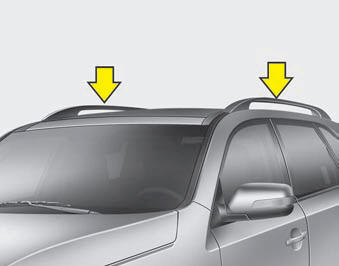Exterior feature

Roof rack (if equipped) If the vehicle has a roof rack, you can load cargo on top of your vehicle.
NOTICE
If the vehicle is equipped with a sunroof,
be sure not to position cargo onto the
roof rack in such a way that it could
interfere with sunroof operation.
CAUTION
• When carrying cargo on the roof
rack, take the necessary precautions
to make sure the cargo does
not damage the roof of the vehicle.
• When carrying large objects on the roof rack, make sure they do not exceed the overall roof length or width.
• When you are carrying cargo on the roof rack, do not operate the sunroof (if equipped).
WARNING
• The following specification is the
maximum weight that can be
loaded onto the roof rack.
Distribute the load as evenly as possible on the roof rack and secure the load firmly.
Loading cargo or luggage in excess of the specified weight limit on the roof rack may damage your vehicle.
• The vehicle center of gravity will be higher when items are loaded onto the roof rack. Avoid sudden starts, braking, sharp turns, abrupt maneuvers or high speeds that may result in loss of vehicle control or rollover resulting in an accident.
• Always drive slowly and turn corners
carefully when carrying
items on the roof rack. Severe
wind updrafts, caused by passing
vehicles or natural causes, can
cause sudden upward pressure
on items loaded on the roof rack.
This is especially true when carrying large, flat items such as wood panels or mattresses. This could cause the items to fall off the roof rack and cause damage to your vehicle or others around you.
• To prevent damage or loss of cargo while driving, check frequently before or while driving to make sure the items on the roof rack are securely fastened.
See also:
Battery
For best battery service
• Keep the battery securely mounted.
• Keep the battery top clean and dry.
• Keep the terminals and connections
clean, tight, and coated with petroleum
jelly or t ...
Key
Illuminated ignition switch
Whenever a front door is opened, the
ignition switch will be illuminated for your
convenience, provided the ignition switch
is not in the ON position. The light will ...
Best-in-Class Performance
The 2011 Sorento offers two engines, both more powerful than the Ford Escape
and Honda CR-V. A 3.5-liter V6 providing best-in-class 276 horsepower and 248
pound-feet of torque and a 2.4-liter four ...


